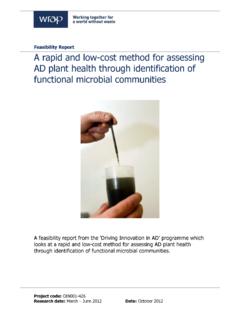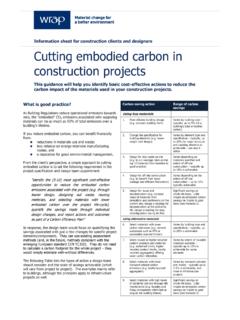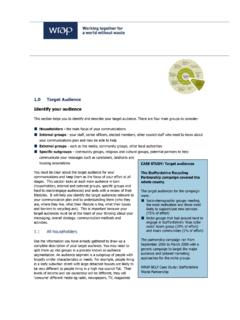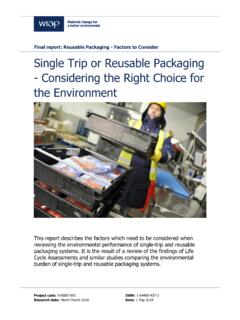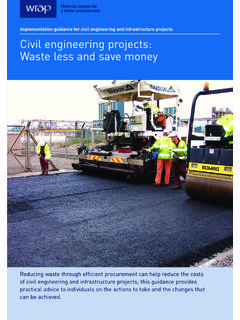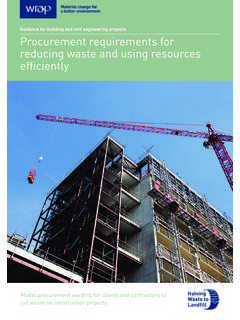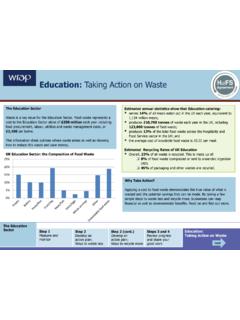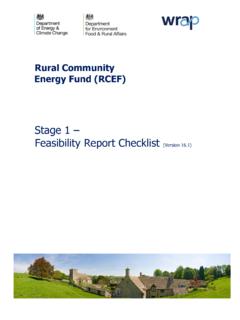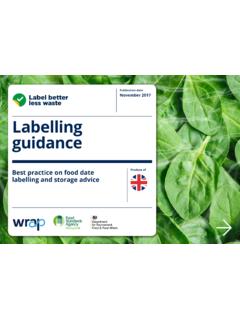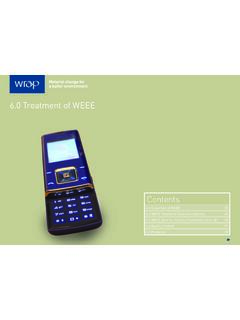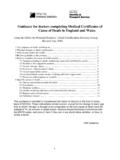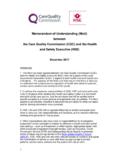Transcription of 5. Legislation - WRAP
1 5. Legislation Civic amenity sites, now known as household waste and recycling centres (HWRCs), were originally set up under the Civic Amenities Act 1967. This stated in Part III (18) that the duty of a local authority was: to provide places where refuse, other than refuse falling to be disposed in the course of a business, may be deposited at all reasonable times free of charge by persons resident in the area of the authority and, on payment of such charges (if any) as the authority think fit, by other persons.'. Since the 1967 Act there have been numerous legislative changes, such as the Waste Electrical and Electronic Equipment (WEEE) Regulations, to define the responsibilities of local authorities and influence the management and recycling requirements at HWRCs.
2 The overarching Legislation is discussed in this section, starting with a focus on the legal definitions of waste, including different types of waste. Health and safety issues and responsibilities are also discussed in detail. Definition of waste Understanding and applying the definition of waste, and those of different types of waste, is a vital aspect of managing HWRCs. These definitions can fundamentally affect the operation of sites, including requirements to charge for disposal of certain wastes. The Government plans to publish guidance on the legal definition of waste and its application. In the meantime, Defra's draft guidance for consultation on the definition of waste from 2010 may be of use. The Waste Framework Directive (2008/98/EC) defines waste as: any substance or object which the holder discards or intends or is required to discard.
3 '. Waste managed at HWRCs should be household, industrial or commercial waste. All these wastes are classed as controlled waste', which is defined in section 75 of the Environmental Protection Act 1990 (EPA. 1990) and through the Controlled Waste (England and Wales) Regulations 2012. Although generically HWRCs could take in all controlled waste it depends on their permit in England and Wales or Licence in Scotland as to whether they can actually take them in on a site specific basis. Household waste Household waste' is defined in the EPA 1990, and comprises: all waste collected by waste collection authorities (WCAs) under section 45(1) of the EPA 1990;. all waste arisings from HWRCs established under section 51(1)(b) of the EPA 1990, as explained in Section ; and waste collected by third parties for which collection or disposal re-use or recycling credits are paid under section 52 of the EPA 1990.
4 It should be noted that the Controlled Waste (England and Wales) Regulations 2012 have also more recently provided a definition of what is considered Household Waste. Municipal waste The definition of municipal waste as described in the Landfill Directive includes both household waste and waste from other sources which is similar in nature and composition. This is likely to include a significant amount of waste generated by businesses and not collected by local authorities. Before the directive was implemented in the UK, municipal waste' referred to waste collected by local authorities. In 2010, following a consultation and negotiations with the EU Commission, national targets were redefined and in future references to municipal waste' will refer to the new definitions, as set out in the Defra note Local authority collected waste Definition of Terms': Local authority collected municipal waste (LACMW) refers to the previous municipal' element of the waste collected by local authorities.
5 It includes household waste and business waste, as well as other waste which is similar in nature and composition, as required by the Landfill Directive. Local authority collected waste (LACW) refers to all waste collected by the local authority. This is a slightly broader concept than LACMW, as it would include both municipal waste and non-municipal fractions, including construction and demolition waste. DIY, construction and demolition waste Construction and demolition waste from households is not defined as household waste for the purposes of section 51 of the EPA 1990, which sets out the duty for waste disposal authorities (WDAs) to provide HWRCs to residents to dispose of their household waste. DIY waste is classed as household waste if it results from work a householder would normally carry out.
6 However interpretation differ on the householder's ability to perform certain home improvement tasks and if a householder employs the services of a trades person to perform domestic tasks consideration must be given the classification of the resultant waste. Examples of construction and demolition waste from households could include: doors and windows;. fitted kitchens;. fitted wardrobes;. inert material such as rubble, concrete, bricks and roof tiles;. plasterboard;. soil from landscaping activities; and any other building materials. Local authorities understand that such waste can be generated by householders, and they therefore need to dispose it. Several authorities have limited the quantity that can be disposed of for free within their HWRC. network, which minimises abuse from traders while providing a service to householders.
7 An example is provided below. Example Leicestershire County Council states on its website that, like many local authorities, it accepts construction and demolition waste from households at HWRCs. To control the input of such wastes, the council restricts the amount that can be delivered to its sites to: six bin liners of construction and demolition waste from each resident's home every six months, brought in a car; and four items that were fitted to the house, such as doors, windows, radiators or fitted units, every six months. This issue is further discussed in Section 7, along with advice on monitoring restrictions. On sites where commercial waste and household waste are collected together, local authorities will need to measure how much waste originates from each source.
8 This is so that they can be reported on separately, as with other types of waste entering the site. Hazardous waste In England and Wales certain wastes are classified as hazardous. In Scotland the term Special Waste is used. Waste is considered 'hazardous' when it contains substances or has properties that might make it harmful to human health or the environment. The Environment Agency's interpretation of the definition and classification of hazardous waste can be found in their technical guidance WM2. WM2 is used by the nations to determine whether waste is considered hazardous/special or not for classification and regulatory purposes. Wastes brought to an HWRC will fall into one of three categories: always hazardous, such as lead acid batteries and fluorescent tubes.
9 Never hazardous, such as edible oil; or may be hazardous and needs to be assessed, such as paint. While some of these wastes are not legally hazardous, they can be difficult to dispose of, causing mess and nuisance if they are disposed of incorrectly, or if spillages or breakages occur. The National Household Hazardous Waste Forum (NHHWF) therefore defines household hazardous waste as: any material discarded by a household which is difficult to dispose of or which puts human health or the environment at risk because of its chemical or biological nature.'. While this is not a legal definition, it clearly indicates that HWRC site staff need to manage some wastes with more care and attention than others. Although it is no longer an active forum, the NHHWF website and the Haz Guide, still host useful and relevant information.
10 The EU Hazardous Waste Directive (HWD) 1991, as amended, aims to provide a Europe-wide definition of hazardous waste and to ensure its correct management and regulation. The HWD identifies wastes which are hazardous, on the grounds that they possess one or more of 14 hazardous properties. A comprehensive list of all wastes, including hazardous waste, is available in the European Waste Catalogue. The HWD is implemented in the UK through the following Legislation : England and Wales: The HWD is implemented through the Hazardous Waste (England and Wales). Regulations 2005 and the Hazardous Waste (Wales) Regulations 2005. These regulations were amended by the Hazardous Waste (England and Wales) (Amendment) Regulations 2009 and the Hazardous Waste (Wales) Amendment Regulations 2009.
